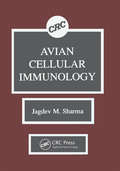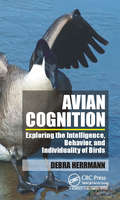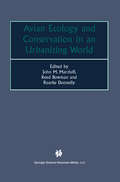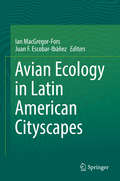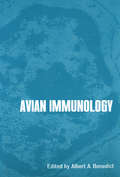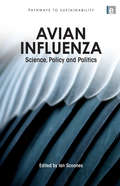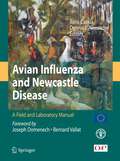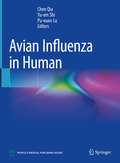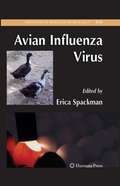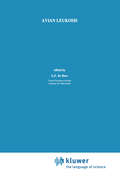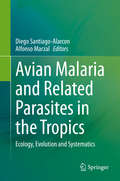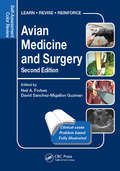- Table View
- List View
The Avian Brood Parasites: Deception at the Nest
by Paul A. JohnsgardThe evolutionary, ecological and behavioral questions posed by obligate brood parasites are among the most intriguing of all contemporary ornithological topics. Avian brood parasites lay their eggs in the nests of other birds and may be a major contributing factor driving several species of songbirds to near extinction. As one of the first books to present a comprehensive overview of this fascinating phenomenon, this work discusses the comparative biology and co-evolutionary adaptations exhibited by the five families of birds that engage in such behavior. Several chapters dealing with the comparative biology of both intraspecific and interspecific brood parasites, are followed by individual accounts of all known species--nearly 100 altogether, primarily cowbirds and cuckoos. Some of the more remarkable behavioral and structural adaptations of these birds include egg mimicry, juvenile mimicry, elimination by starvation or actual attack of other nestlings or host eggs, and even the learning and partial mimicry of host song traits. An extended glossary, a list of Latin names, 400 literature citations and range maps of all parasitic species discussed are also included. Detailed line drawings by the author enhance this synthesis of biological and ecological information.
Avian Brood Parasitism: Behaviour, Ecology, Evolution and Coevolution (Fascinating Life Sciences)
by Manuel SolerBrood parasitism has become one of the most flourishing areas of research in evolutionary ecology and one of the best model systems for investigating coevolution. This subject has undergone remarkable advances during the last two decades, but has not been covered by any book in the 21st century. This book offers a comprehensive and up-to-date overview of the fascinating field of avian brood parasitism. The topics covered include conspecific brood parasitism; evolution and phylogenetic history of avian brood parasites; parasitic behaviour used by brood parasites; adaptations and counter-adaptations of brood parasites and their hosts at every stage of the breeding cycle (before laying, egg, chick and fledgling stages); factors affecting the evolution of host defences and parasitic attacks; the role of phenotypic plasticity in host defences; mechanisms driving egg recognition and rejection; evolution of nest sharing or nest killing by brood parasite chicks; begging behaviour in parasitized nests and food delivery by host adults; and recognition of conspecifics by juvenile brood parasites. This volume provides a comprehensive reference resource for readers and researchers with an interest in birds, behaviour and evolution, as well as a source of hypotheses and predictions for future investigations into this dynamic subject.
Avian Cellular Immunology
by JagdevM. SharmaKnowledge regarding avian cellular immunity has expanded rapidly within the last few years and new information continues to accumulate. It is now a well-established fact that cell-mediated immunity plays a major role in the defense against neoplastic and non-neoplastic diseases in chickens. The principle objective of Avian Cellular Immunology is to compile the latest information available on various aspects of avian cellular immunity. The book contains chapters written by leading experts in the field and covers topics including cell surface markers, T-cell immunity, natural immune functions, the role of macrophages in cellular immune functions, cellular immune suppression and tolerance, cellular immune systems in avian species other than chickens, the role of cellular immunity in neoplastic and non-neoplastic viral diseases, cell-mediated immune mechanisms in bacterial and parasitic infections, and autoimmune disorders.
Avian Cellular Immunology
by JagdevM. SharmaKnowledge regarding avian cellular immunity has expanded rapidly within the last few years and new information continues to accumulate. It is now a well-established fact that cell-mediated immunity plays a major role in the defense against neoplastic and non-neoplastic diseases in chickens. The principle objective of Avian Cellular Immunology is to compile the latest information available on various aspects of avian cellular immunity. The book contains chapters written by leading experts in the field and covers topics including cell surface markers, T-cell immunity, natural immune functions, the role of macrophages in cellular immune functions, cellular immune suppression and tolerance, cellular immune systems in avian species other than chickens, the role of cellular immunity in neoplastic and non-neoplastic viral diseases, cell-mediated immune mechanisms in bacterial and parasitic infections, and autoimmune disorders.
Avian Cognition: Exploring the Intelligence, Behavior, and Individuality of Birds
by Debra S. HerrmannUnlike any other book, Avian Cognition thoroughly examines avian intelligence, behavior, and individuality. Preferences, choices, motivation, and habits of species, flocks, and individual birds are discussed and compared. This book investigates who birds are and why they do what they do. Daily, seasonal, and play activities, creativity, reasoning a
Avian Desert Predators (Adaptations of Desert Organisms)
by William E. CookUnlike mammals, birds are not particularly well suited to desert life. Among the few types of birds that have successfully adapted to the desert ecosystem are the predators. With individual chapters devoted to each of the different species, the book explores those attributes which make this group suited to desert life, and how they have developed their abilities to cope with the prevailing harsh conditions. This readily accessible volume collates a substantial amount of the latest research on this fascinating subject.
Avian Ecology and Conservation in an Urbanizing World
by Reed Bowman Roarke Donnelly John M. MarzluffOne of the most striking and persistent ways humans dominate Earth is by changing land-cover as we settle a region. Much of our ecological understanding about this process comes from studies of birds, yet the existing literature is scattered, mostly decades old, and rarely synthesized or standardized. The twenty-seven contributions authored by leaders in the fields of avian and urban ecology present a unique summary of current research on birds in settled environments ranging from wildlands to exurban, rural to urban. Ecologists, land managers, wildlife managers, evolutionary ecologists, urban planners, landscape architects, and conservation biologists will find our information useful because we address the conservation and evolutionary implications of urban life from an ecological and planning perspective. Graduate students in these fields also will find the volume to be a useful summary and synthesis of current research, extant literature, and prescriptions for future work. All interested in human-driven land-cover changes will benefit from a perusal of this book because we present high altitude photographs of each study area.
Avian Ecology in Latin American Cityscapes
by Ian MacGregor-Fors Juan F. Escobar-IbáñezThis book gathers a representative sample of the relevant knowledge related to the ecology, behavior, and conservation of birds in urban Latin America. Latin America is one of the most biodiverse regions of the world, yet it is still understudied. Although it concentrates most of its population in rapidly growing cities under considerable economic, social, and environmental disparity, the study of the effects that urbanization has on biodiversity in Latin America is still insufficient. Among the best-studied wildlife groups, birds have been widely used as bioindicators in urban areas. Going from general to specific information regarding avian communities, populations, behavior, threats, and conservation issues, this book describes the state-of-the-art of avian urban ecology in the region. Such knowledge will hopefully promote the regional consolidation of the field and encourage future mechanistic studies that untangle the recorded patterns in order to have the required information to bridge the gap between evidence-based knowledge and practice in urban systems. Thus, the information included in this document will allow scientists, students, and even decision takers to relate with the current knowledge and gaps related to the topic, providing perspective for future studies and actions.
Avian Energetics and Nutritional Ecology
by C. CareyA symposium held in 1973 chaired and organized by William R. Dawson was the first major attempt to summarize and synthesize the existing information in the then emerging field of avian energetics. The symposium featured papers by James R. King, William A. Calder III, Vance A. Tucker, and Robert E. Ricklefs and com mentaries by George A. Bartholomew, S. Charles Kendeigh, and Eugene P. Odum. The proceedings of the symposium, Avian Energetics (Paynter 1974), played a critical role in stimulating interest and research in the field of avian energetics. Some twenty-odd years later, we are making another attempt to summarize the information in the field of avian energetics. Some obvious differences exist be tween its predecessor and this volume. Numerous improvements in methodology, such as the use of doubly labeled water to estimate metabolism in free-living birds, now allow researchers to ask questions that could not be addressed previ ously. Second, consideration of nutrition is now inseparable from that of energet ics. This merger is necessary not only because food intake is the source of both en ergy and nutrients but also because one or more nutrients, rather than energy, can be limiting for a given species in a particular instance. Finally, the study of ener getics and nutritional ecology, particularly in birds and mammals, has grown so dramatically that a single volume can now only partially cover the range of possi ble topics and can catalogue only a sampling of all the studies on the subject.
Avian Evolution: The Fossil Record of Birds and its Paleobiological Significance (TOPA Topics in Paleobiology)
by Gerald MayrKnowledge of the evolutionary history of birds has much improved in recent decades. Fossils from critical time periods are being described at unprecedented rates and modern phylogenetic analyses have provided a framework for the interrelationships of the extant groups. This book gives an overview of the avian fossil record and its paleobiological significance, and it is the only up-to-date textbook that covers both Mesozoic and more modern-type Cenozoic birds in some detail. The reader is introduced to key features of basal avians and the morphological transformations that have occurred in the evolution towards modern birds. An account of the Cenozoic fossil record sheds light on the biogeographic history of the extant avian groups and discusses fossils in the context of current phylogenetic hypotheses. This review of the evolutionary history of birds not only addresses students and established researchers, but it may also be a useful source of information for anyone else with an interest in the evolution of birds and a moderate background in biology and geology.
Avian Evolution: The Fossil Record of Birds and its Paleobiological Significance (TOPA Topics in Paleobiology)
by Gerald MayrKnowledge of the evolutionary history of birds has much improved in recent decades. Fossils from critical time periods are being described at unprecedented rates and modern phylogenetic analyses have provided a framework for the interrelationships of the extant groups. This book gives an overview of the avian fossil record and its paleobiological significance, and it is the only up-to-date textbook that covers both Mesozoic and more modern-type Cenozoic birds in some detail. The reader is introduced to key features of basal avians and the morphological transformations that have occurred in the evolution towards modern birds. An account of the Cenozoic fossil record sheds light on the biogeographic history of the extant avian groups and discusses fossils in the context of current phylogenetic hypotheses. This review of the evolutionary history of birds not only addresses students and established researchers, but it may also be a useful source of information for anyone else with an interest in the evolution of birds and a moderate background in biology and geology.
Avian Flight (Oxford Ornithology Series)
by John J. VidelerBird flight has always intrigued mankind. This book provides an up to date account of our existing knowledge on the subject, as well as offering new insights and challenging some established views. A brief history of the science of flight introduces the basic physical principles governing aerial locomotion. A treatment of flight-related functional morphology concentrates on the difference in shape of the arm and hand part of the wings, on the structure and function of tails, and on the shape of the body. The anatomy and mechanical properties of feathers receive special attention. Aerodynamic principles used by birds are explained in theory by simply applying Newton's laws, and in practice by showing the direction and velocity of the attached flow around an arm wing cross section and of the leading edge vortex flow above a hand wing. The Archaeopteryx fossils remain crucial in our understanding of the evolution of bird flight despite the recent discovery of a range of well-preserved ancient birds. A novel insight into the interactions between wings and air challenges established theories relating to the origin of bird flight. Take-off, flapping flight, gliding and landing are the basic ingredients of bird flight, and birds use a variety of flight styles from hovering to soaring. Flight muscles consisting of mosaics of specialised fibres are the engines that generate the force required to keep the wings and tail in the gliding configuration and perform work during flapping motion. The energy required to fly can be estimated or measured directly, and a comparison of the empirical results provides insights into the trend in metabolic costs of flight of birds varying in shape and mass from hummingbirds to albatrosses.
Avian Genomics in Ecology and Evolution: From the Lab into the Wild
by Robert H. S. KrausBirds catch the public imagination like no other group of animals; in addition, birders are perhaps the largest non-professional naturalist community. Genomics and associated bioinformatics have revolutionised daily life in just a few decades. At the same time, this development has facilitated the application of genomics technology to ecological and evolutionary studies, including biodiversity and conservation at all levels. This book reveals how the exciting toolbox of genomics offers new opportunities in all areas of avian biology. It presents contributions from prominent experts at the intersection of avian biology and genomics, and offers an ideal introduction to the world of genomics for students, biologists and bird enthusiasts alike. The book begins with a historical perspective on how genomic technology was adopted by bird ecology and evolution research groups. This led, as the book explains, to a revised understanding of avian evolution, with exciting consequences for biodiversity research as a whole. Lastly, these impacts are illustrated using seminal examples and the latest discoveries from avian biology laboratories around the world.
Avian Immunology (Advances in Experimental Medicine and Biology #88)
by A. BenedictThe ontogeny of lymphoid cells seems the most appropriate place to start. The early events in T and B cell ontogeny are still confusing. There seems to be no agreement on the data and on the semantics of the question of progenitor vs. stem cells. Nevertheless, we are beginning to understand more about progenitor cells which are committed to particular cell lines, and about stem cells in the sense of having almost unlimited capability of giving rise to undifferentiated progeny. An important future development will be to determine the nature of the substances that attract stem cells and which are produced by specialized thymus epithelium, and perhaps by the bursa. The way stem cells recognize these signals is an important question to answer. Not predictable from mammalian models has been the observation that there is a lack of cells called into the bursa even before the signal for entry of stem cells has been shut off. A likely model suggested that after a certain point in development there were no longer any cells capable of migrating into the bursa and becoming B cells. A fascinating possibility is the suggestion that a cell comes into the bursa, is not committed, then can still wander into the thymus. This cell does not appear to have B cell characteris tics; that is, immunoglobulin is not expressed on its surface.
Avian Influenza: Prevention and Control (Wageningen UR Frontis Series #8)
by Remco S. Schrijver G. KochAvian Influenza has become one of the biggest threats for human and animal health. The old paradigm was that the disease in waterfowl, poultry, pigs and man was caused by separate viruses that each stayed reasonably well within their own niche. The only danger to man was considered being infected by pigs, being the mixing vessel, where avian and human influenza viruses could come together and exchange genetic material to form new viruses that are potentially dangerous to man. This has dramatically proven wrong during the last decade, with huge outbreaks in the USA, Europe, and Asia. The H5N1 strain that caused human deaths in Hong Kong appeared to be transmitted directly from poultry to man. This initiated sudden awareness that pigs were not a necessary intermediate in the transmission chain. During the AI outbreaks in Italy, mutation of low-pathogenicity viruses into high-pathogenicity viruses in poultry appeared another new threat, and further evidence that the poultry sector had a wolf in sheep’s clothing. It put pressure on development of diagnostic methods that could be used in large monitoring programmes. In The Netherlands a human fatality, after increased reports of conjunctivitis during a H7N7 outbreak, signalled that different AI strains could be fatal to man. Also, the huge economic losses and difficulties in controlling the spread of the infection in densely populated poultry areas, problems with vaccination and lack of marker vaccines demonstrated that the current control policy must be improved. These events led to an international AI conference with experts from Asia, USA and Europe. In this book you will find new views on the issues, expert opinions and the results of in-depth discussions among avian experts of around the world that do not want to give up against this dangerous virus.
Avian Influenza: "Science, Policy and Politics"
by Ian ScoonesOver the past decade, substantial resources have been spent on tackling avian influenza and building a global capacity for a pandemic response. The catastrophic costs of the 1918 influenza pandemic are well documented, and the swine flu pandemic of 2009-10 has raised the alarm yet again. Across the world, surveillance systems have been upgraded, stockpiles of antiviral drugs and influenza vaccines have been created, veterinary and public health systems have been improved and poultry production and marketing has been dramatically restructured. What are the lessons from this experience? And what does this suggest for the future? This book explores how virus genetics, ecology and epidemiology intersect with economic, political and policy processes in a variety of places - from Bangkok to Washington, to Jakarta, Cairo, Rome and London. It focuses on the interaction of the international and national responses - and in particular the experiences of Cambodia, Vietnam, Indonesia and Thailand. It asks how effective is the disease surveillance and response system - can it respond to a new pandemic threat? The comparative analysis reveals the challenges and limitations of a technocratic, centralised response, and the need to take seriously local contexts. Drawing from these experiences, the book concludes with a discussion of future prospects and challenges, examining in particular what a 'One World, One Health' approach - where approaches to animal, human and ecosystem health are integrated - would look like in practice. Published in association with the Economic and Social Research Council (ESRC)
Avian Influenza: "Science, Policy and Politics"
by Ian ScoonesOver the past decade, substantial resources have been spent on tackling avian influenza and building a global capacity for a pandemic response. The catastrophic costs of the 1918 influenza pandemic are well documented, and the swine flu pandemic of 2009-10 has raised the alarm yet again. Across the world, surveillance systems have been upgraded, stockpiles of antiviral drugs and influenza vaccines have been created, veterinary and public health systems have been improved and poultry production and marketing has been dramatically restructured. What are the lessons from this experience? And what does this suggest for the future? This book explores how virus genetics, ecology and epidemiology intersect with economic, political and policy processes in a variety of places - from Bangkok to Washington, to Jakarta, Cairo, Rome and London. It focuses on the interaction of the international and national responses - and in particular the experiences of Cambodia, Vietnam, Indonesia and Thailand. It asks how effective is the disease surveillance and response system - can it respond to a new pandemic threat? The comparative analysis reveals the challenges and limitations of a technocratic, centralised response, and the need to take seriously local contexts. Drawing from these experiences, the book concludes with a discussion of future prospects and challenges, examining in particular what a 'One World, One Health' approach - where approaches to animal, human and ecosystem health are integrated - would look like in practice. Published in association with the Economic and Social Research Council (ESRC)
Avian Influenza and Newcastle Disease: A Field and Laboratory Manual
by Illaria Capua Dennis J. AlexanderAvian Influenza (AI) and Newcastle Disease (ND) are two devastating diseases of poultry, which cause losses to the poultry industry and influence the liveability of rural communities worldwide. Following the H5N1 epidemic they appear to be endemic at least in Asia, Eastern Europe, The Middle East and Africa. Particularly in case of AI outbreaks it is essential that infection is diagnosed promptly and that isolates are made available to the international scientific community.Currently, several organisations including OIE, FAO and the EC have organised training courses in affected areas. However, often these courses do not cover all aspects of AI/ND diagnosis but only certain aspects. This results in fragmented areas of knowledge and in the application of different diagnostic protocols in different parts of the world. The objective of this book is to provide a comprehensive approach to AI diagnosis ranging from the clinical elements that should trigger a suspicion in the field, to the post mortem technique, collection of samples, processing/ shipment of specimens, virological, serological and molecular diagnosis and guidelines for notification.
Avian Influenza in Human
by Pu-Xuan Lu Chen Qiu Yu-Xin ShiSome avian influenza viruses can infect humans, cause disease, and even result in deaths. This book comprehensively and systematically presents the theory, diagnosis and clinical treatment of typical avian influenza viruses in human. The first chapters introduce the ethiology, epidemiology, clinical diagnosis and treatment of human avian influenza and complications. The following chapters include overview, extensive images, differential diagnosis and clinical cases of H7N9, H5N1, H5N6, H10N8, H9N2 and H7N4 avian influenza. Written by practitioners directly involved in the prevention and clinical treatment of human avian influenza, it will be an invaluable aid for practitioners in centers for infectious disease control and prevention, hospitals, and academic institutions to improve prevention, diagnosis and treatment of avian influenza in human.
Avian Influenza Virus (Methods in Molecular Biology #436)
by Erica SpackmanWith the growing global fear of a major pandemic, avian influenza (AI) virus research has greatly increased in importance. In Avian Influenza Virus, an expert team of researchers and diagnosticians examine the fundamental, yet essential, virological methods for AI virus research and diagnostics as well as some of the newest molecular procedures currently used for basic and applied research. They present exciting, cutting-edge new methods that focus both on studying the virus itself and on work with avian hosts, an area greatly lacking in research.
Avian Leukosis (Developments in Veterinary Virology #4)
by G. F. BoerThe intention of the series Developments in Veterinary Virology is to provide monographs dealing with the major animal viral diseases. Each volume will include the latest achievements in fundamental research and practical applications and should be readable for people from various disciplines and different backgrounds. The multi-author approach provides the best opportunity to keep each chapter at the highest level and makes the composition of the volumes manageable to the editors. This monograph on Avian Leukosis presents comprehensive reviews on the recent history of avian retrovirus research, on epizootiological, virological, pathological aspects, on tumor induction, the immune response to avian retro viruses, virus-cell interactions and on techniques for diagnosis. The volume deals mainly with exogenous avian leukosis virus (ALV) infections, but one chapter is entirely devoted to endogenous avian leukemia virus. Molecular biology aspects are confined to various oncogenes and to lymphoma induction since retroviruses, including those specific for avian species, have recently been described in detail in the Cold Spring Harbor Laboratory series "Molecular Biology of Tumor Viruses". Two chapters are devoted to the practical application of insights obtained from avian leukosis research: influences of AL V infection on production performance and eradication procedures.
Avian Malaria and Related Parasites in the Tropics: Ecology, Evolution and Systematics
by Diego Santiago-Alarcon Alfonso MarzalThe Tropics are home to the greatest biodiversity in the world, but tropical species are at risk due to anthropogenic activities, mainly land use change, habitat loss, invasive species, and pathogens. Over the past 20 years, the avian malaria and related parasites (Order: Haemosporida) systems have received increased attention in the tropical regions from a diverse array of research perspectives. However, to date no attempts have been made to synthesize the available information and to propose new lines of research. This book provides such a synthesis by not only focusing on the antagonistic interactions, but also by providing conceptual chapters on topics going from avian haemosporidians life cycles and study techniques, to chapters addressing current concepts on ecology and evolution. For example, a chapter synthesizing basic biogeography and ecological niche model concepts is presented, followed by one on the island biogeography of avian haemosporidians. Accordingly, researchers and professionals interested in these antagonistic interaction systems will find both an overview of the field with special emphasis on the tropics, and access to the necessary conceptual framework for various topics in ecology, evolution and systematics. Given its conceptual perspective, the book will appeal not only to readers interested in avian haemosporidians, but also to those more generally interested in the ecology, evolution and systematics of host-parasite interactions.
Avian Medicine
by Jaime SamourCombining the in-depth coverage of a text with the practicality of a clinical manual and the visual detail of an atlas, Avian Medicine, 3rd Edition is the complete, all-in-one guide to every aspect of avian care. Written by some of the world's leading authorities in avian medicine, this highly illustrated reference covers a wide variety of avian species — including psittacines, raptors, bustards, parrots, finches, and more. Comprehensive coverage includes issues ranging from the basic aspects of patient management to the most sophisticated diagnostic techniques. Plus, with more illustrations, a wealth of practical advice, and the latest information on cutting-edge treatments and procedures incorporated into this new edition, today's general clinician will be fully equipped to effectively and confidently care for all birds. - Comprehensive coverage of all aspects of clinical management written by leading experts in the field provides readers with a depth and breadth of knowledge on avian medicine and care. - Coverage of a wide variety of species — including raptors, bustards, and many others — enables practitioners to treat a greater assortment of patients with more confidence and skill. - Bulleted text and tables help present information in an accessible way. - More than 900 color images give readers a better picture of disease and how it will be encountered in practice. - Appendices bring together wide-ranging data on hematology and blood chemistry reference values, commonly used pharmaceutics and other information relevant to avian practitioners. - NEW! New chapter sections, revised references, and updated suggested readings ensure that readers have the most up-to-date information. - NEW! New chapter contributors ensure the information in the text reflects the most current techniques and advances. - NEW! Expanded content on parrots, finches and fruit-eating birds has been added to the text to make content more relevant to the needs of today's practitioners. - NEW! Thoroughly updated content includes the latest surgical techniques and procedures to keep practitioners on top of the most cutting-edge information in the field. - NEW! Additional content and images on MRI have been incorporated throughout the text to complete the coverage of other advanced imaging techniques such as CT scans.
Avian Medicine and Surgery: Self-Assessment Color Review, Second Edition (Veterinary Self-Assessment Color Review Series)
by Neil A. Forbes David Sanchez-Migallon GuzmanThis completely revamped second edition of Avian Medicine and Surgery includes over 260 all-new colour illustrated cases, with questions and answers fully exploring a breadth of diseases and disorders. Avian patients are a routine part of the veterinary case load and are being seen by many clinicians across the world. This book provides a unique quick reference for clinicians and a useful self-test for students by offering comprehensive, clinically-oriented information that can be quickly accessed, easily understood and applied. With contributions from leading international authorities with diverse fields of expertise, the book covers a wide range of disciplines, organ systems and species. The cases are presented in a random order, just as they would appear in daily practice, challenging the reader to address real clinical situation and offering, where possible, a comprehensive solution.
Avian Medicine and Surgery: Self-Assessment Color Review, Second Edition (Veterinary Self-Assessment Color Review Series)
by Neil A. Forbes David Sanchez-Migallon GuzmanThis completely revamped second edition of Avian Medicine and Surgery includes over 260 all-new colour illustrated cases, with questions and answers fully exploring a breadth of diseases and disorders. Avian patients are a routine part of the veterinary case load and are being seen by many clinicians across the world. This book provides a unique quick reference for clinicians and a useful self-test for students by offering comprehensive, clinically-oriented information that can be quickly accessed, easily understood and applied. With contributions from leading international authorities with diverse fields of expertise, the book covers a wide range of disciplines, organ systems and species. The cases are presented in a random order, just as they would appear in daily practice, challenging the reader to address real clinical situation and offering, where possible, a comprehensive solution.


